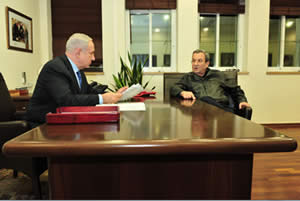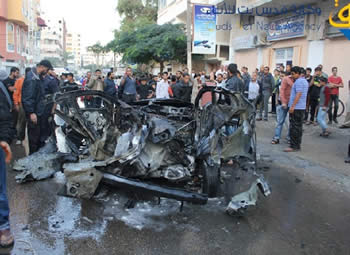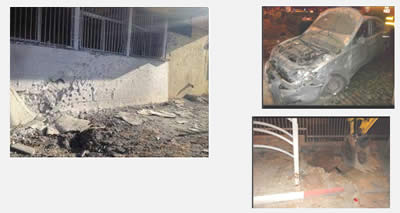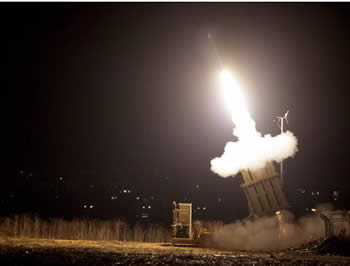http://www.terrorism-info.org.il/en/article/20425
Overview
1. On the afternoon of November 14, 2012, the IDF began Operation Pillar of Defense in the Gaza Strip. The opening shot was the targeted killing of Ahmed al-Jaabari, commander of Hamas’ military-terrorist wing, followed by severe Israeli Air Force strikes on the stockpiles of Iranian-supplied Fajr-5 long range rockets belonging to Hamas and the Palestinian Islamic Jihad.
2. In response the terrorist organizations attacked Israel with massive barrages of rocket fire. Until the afternoon of November 15, more than 200 rockets had landed in Israeli territory, about half of them with ranges of 40 kilometers (about 25 miles), focusing on Beersheba. So far three Israeli civilians, two men and a woman, have been killed. The Israeli Red Magen David has reported treating an estimated 45 civilians wounded to a greater or lesser degree. There has also been considerable property damage.
3. The objectives of the Operation, as stated by Israeli Minister of Defense Ehud Barak at a November 14 press conference, are the following:
1) To strengthen Israel’s capabilities to deter the terrorist organizations operating in the Gaza Strip.
2) To strike a decisive blow to the terrorist organizations’ rocket firing capabilities.
3) To strike a decisive blow to Hamas and the other terrorist organizations operating in the Gaza Strip.
4) To minimize insofar as possible the damage to the Israeli home front (“In the past 24 hours Israel has made it clear that it will not tolerate rocket and missile attacks on its civilians.”[1])
4. Operation Pillar of Defense was motivated by the erosionof Israel’s deterrent capabilities since Operation Cast Lead (December 2008-January 2009). That could be seen in the significant increase in the amount of rocket fire from the Gaza Strip since 2010, the frequent rounds of escalation in rocket fire resulting from the terrorist activity of Hamas and the other terrorist organizations, and the shortening of the lulls between the rounds of escalation during the past six months (See the graphs).
5. The rocket fire, which disrupted the lives of more than one million Israelis living in the country’s south, was frequently accompanied by attacks on Israeli soldiers carrying out counterterrorism activities near the security fence along the Gaza Strip border. In addition, networks in the Gaza Strip and Sinai Peninsula, interconnected and affiliated with the global jihad, became more daring, and turned the Sinai Peninsula into a launching pad for terrorist attacks against Israel.

Minister of Defense Ehud Barak and Israeli Prime Minister Benyamin Netanyahu consult about Operation Pillar of Defense in the prime minister’s office, Tel Aviv (Picture by Ariel Hermoni, Ministry of Defense, November 14, 2012).
The Targeted Killing of Ahmed al-Jaabari
6. At around 1600 hours on November 14, in a joint IDF-Israel Security Agency operation, the IDF attacked a car driving through a main thoroughfare in Gaza City carrying Ahmed al-Jaabari, Hamas’ senior military-terrorist commander.[2] Ahmed al-Jaabari was killed, as was Mohammed al-Hums, a Hamas operative and his aide.
7. Al-Jaabari, who had headed the Izz al-Din al-Qassam Brigades for the past five years, was directly responsible for constructing Hamas’ military-terrorist infrastructure and conducting its terrorist activities. He commanded attacks on IDF soldiers and Israeli civilians, including attacks originating in the Sinai Peninsula, and rocket and mortar shell fire. He was also responsible for the abduction and continued captivity of Gilad Shalit (See Appendix I). According to the Fatah-affiliated PalPress news agency, Hamas appointed Marwan Issa, one of the senior figures in the Izz al-Din al-Qassam Brigades, to replace al-Jaabari (PalPress, November 15, 2012).

Ahmed al-Jaabari’s car after the IDF strike, in the center of Gaza City (Qudsnet website, November 14, 2012).
8. A short time after the attack on al-Jaabari the IDF carried out strikes on additional senior terrorist operatives in the Izz al-Din al-Qassam Brigades and the Palestinian Islamic Jihad (PIJ). Israeli Air Force aircraft also attacked storage sites for weapons and rocket-launching pits used to hold Fajr-5 long-range rockets, almost preventing the terrorist organizations from using them against population areas in the center of Israel (See Appendix II for technical details of the Fajr-5). It was a significant blow to the terrorist organizations’ ability to launch long-range rockets, especially Hamas and the PIJ. It was also a significant blow to the underground launching systems and weapons’ stockpiles of the terrorist organizations in the Gaza Strip (IDF Spokesman, November 15, 2012), although they preserved some collateral capability.
Reaction of the Terrorist Organizations: Massive Rocket Fire Attacks on Israel
Aggressive Media Rhetoric
9. Shortly after the killing of Ahmed al-Jaabari, terrorist organization spokesmen in the Gaza Strip issued statements calling it “a declaration of war” and “the opening of the gates of hell,” and promised an aggressive response. Hamas’ military-terrorist wing issued a notice of the death of its commander, calling it “the beginning of a war of liberation” and a milestone [on the road to] the end of Israel (“the monstrous entity”) (Izz al-Din al-Qassam Brigades website, November 14, 2012). Most of the Gaza Strip terrorist organizations announced a general mobilization of their operatives (Al-Jazeera, November 14, 2012). The ministry of culture and education of the de-facto Hamas administration announced the closing of schools and universities throughout the Gaza Strip.
10. The media, especially Hamas’ Al-Aqsa TV, have been playing songs calling for the continuation of rocket fire into Israeli territory. Al-Aqsa TV has also made prominent mention of the rocket fired on the morning of November 15 which killed three Israeli civilians in Kiryat Malachi (Al-Aqsa TV, November 15, 2012).
Responses on the Ground
11. Following the Israeli strikes, Hamas and the other terrorist organizations in the Gaza Strip initiated massive barrages of rocket fire, launching scores of rockets into Israeli territory. The attack on Beersheba, the largest city in Israel’s south, was particularly massive. Rockets were also fired at Ashdod, Netivot and Ashqelon. On November 14 an estimated 40 rocket hits were identified. Most of them had ranges of 40 kilometers and were fired at Beersheba. The Iron Dome aerial defense system intercepted and destroyed 27 rockets. The rocket fire continued throughout the afternoon and night.

Left: Rocket damage to a school in the southern town of Ofaqim. Right: Rocket fire damage in Beersheba (Israel Police Force Facebook page, November 14, 2012).
12. On the morning of November 15, after a number of relatively quiet hours, the rocket fire, more intensive this time, was renewed. During the morning, barrages of rockets were launched at Ashdod, Ashqelon, Beersheba, Ofaqim, Gan Yavneh and Kiryat Malachi (all cities about 40 kilometers, or 25 miles, from the Gaza Strip). Rockets were also fired at towns and villages closer to the Gaza Strip. Most glaring were the following incidents (as of noon, November 15):
1) At around 0800 hours a barrage of rockets was fired at Gan Yavneh and Kiryat Malachi. One of the rockets hit the top floor of an apartment building in Kiryat Malachi, killing three Israeli civilians and wounding six, among them a four-year old boy and two baby girls. Another building suffered a direct hit but there were no casualties. Hamas claimed responsibility for the rocket fire and its media boasted of the event.
2) A barrage of rocket fire targeted Ashdod. One of the rockets hit a residential dwelling. There were no casualties.
3) A school in Ofaqim took a direct hit. There were no casualties.
|
13. As of 1200 hours, November 15, more than200 rocket hits had been identified in Israeli territory (Note: the number of attempted launchings was far larger). Most of the rockets landed on the morning of November 15. The Iron Dome aerial defense system successfully intercepted and destroyed an estimated 30 rockets (IDF Spokesman, November 15, 2012). |

Iron Dome aerial defense system (Photo by Edi Israel, courtesy of NRG, November 14, 2012).
Rocket Fire from the Sinai Peninsula
14. On the afternoon of November 14, close to the beginning of Operation Pillar of Defense, it was reported that four rockets were fired from the direction of the Sinai Peninsula into Israeli territory. It was also reported that Israel had lodged a complaint with Egypt regarding the rocket fire. Senior security personnel in the northern Sinai Peninsula denied the attack. Later, Egyptian security sources reported that following the rocket fire a committee had been appointed to investigate the incident (Al-Yawm Al-Sabaa, November 14, 2012).
15. The incident was unconnected to the rocket fire responses to Operation Pillar of Defense. However, in our assessment it manifests the turning of the Sinai Peninsula into an arena for anti-Israeli terrorism, in addition to the direct security threats from the Gaza Strip.









